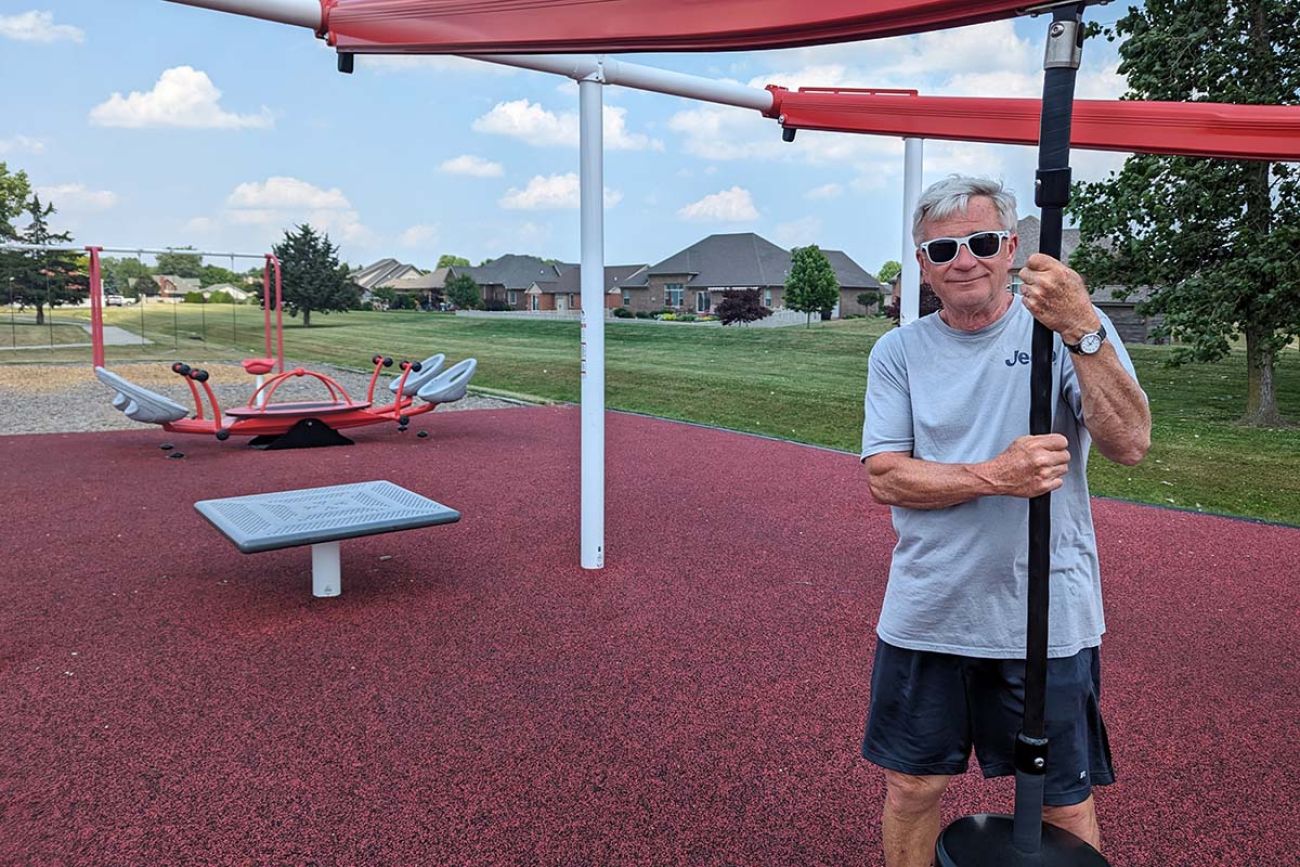Ohio helps make Michigan No. 1 in weed sales — but perhaps not for long

- Michigan reportedly sells the most legal cannabis of any state between the coasts, benefitting from customers in neighboring states where it is not legal
- But Ohio legalized recreational cannabis last November and retailers there are expected to begin sales as early as this month
- Experts say the change will eventually dig into sales in Michigan, where dozens of cannabis retailers have positioned themselves close to the Ohio border
Michigan’s status as the Midwest’s top weed-selling state — its $3.2 billion in annual sales bolstered by residents from neighboring states — faces a new challenge: Ohio will soon have its own burgeoning recreational cannabis market.
That change, starting as early as this month, is expected to take a bite out of Michigan’s cannabis sales, which at times have even surpassed sales in California, a state with four times the population and a long history of legal marijuana use.
But it could take years before Ohio’s market matures enough, experts say, to stop the thousands of Ohioans from crossing the border for their weed needs.
“Usually it takes 18 to 24 months just to start off a program … and get something up and running,” said Beau Whitney, chief economist for the National Industrial Hemp Council of America.
That gives Michigan’s retailers — and the municipalities getting hundreds of thousands of dollars in marijuana tax money — some time before they face substantial competition.
As of now, there’s not much competition, said Andrew Narvaez, a Toledo resident who talked with Bridge Michigan as he visited King of Budz, a marijuana retailer just 12 miles north of the Ohio border.
He said the cost for medicinal marijuana in Ohio is four times higher than recreational marijuana in Michigan. So, for now he said, it’s just a better deal to head north to Monroe Township, where seven stores form a “green mile” of marijuana businesses on LaPlaisance Road that begins at I-75.
“It needs to be as cheap if not cheaper,” said Narvaez, 32, for him to buy marijuana in Ohio.
It wasn’t always cheap in Michigan: In 2020, an ounce of flower cannabis went for over $400; by 2023 and this year, it had fallen to just under $90. It could take the Ohio marijuana market a long time to grow and have enough competition to get to the same point.
Ohio legal, but it will take time to grow
All told, Monroe Township has 16 marijuana retailers; exceeded only by Detroit, Ann Arbor, Lansing, Grand Rapids and Kalamazoo — all cities whose populations dwarf the township’s population of just over 14,300 people.
Related:
- Marijuana edibles, vape pens in Michigan schools prompt calls for reform
- Michigan local governments getting $87 million from marijuana sales
- Michigan marijuana industry sees record sales, even as some struggle
Jeff Hall, city administrator of tiny Morenci in Lenawee County, literally bordering Ohio, knows exactly why five retailers chose his small, 2,200-person city: It’s on the border. The city capped the number of stores at five but Hall said more wanted to set up shop.
“We had quite a lengthy list that wanted in,” he said.
Ohioans make up roughly half of the customers at the Monroe Township stores, according to a Bridge Michigan review of cars in retailers’ parking lots, and make up to 70% of all sales in the township’s retailers, township Supervisor Alan Barron told Bridge.

Border towns in other parts of Michigan also get waves of customers from neighboring states. Retailers set up shop in New Buffalo, near the Indiana line, and in Menominee and other Upper Peninsula counties bordering Wisconsin.
Every Michigan county that borders Wisconsin, Indiana and Ohio has cannabis retailers and their proximity to those states is part of the allure: Bridge estimates that more than 5 million people in those states are within 100 miles of the Michigan border.
But now, the biggest market — Ohio — is allowing recreational sales. It will take time to add stores and capacity. But as that market expands, it will eventually have a negative impact on Michigan sales, Whitney said.
“A lot of your retailers bordering Ohio, they’re going to be hit the hardest, and so their revenue is going to go down,” said Whitney of the National Cannabis Industry Association. “What I’m forecasting in Michigan is an actual decline in revenue,” as demand for cannabis in Ohio increases, he said.
The change won’t happen overnight. It will depend on how quickly the state can convert its medicinal shops for recreational use.
In the Toledo area, where many Michigan marijuana customers who are coming in from Ohio live, none of the existing medicinal cannabis stores are big enough to rival those in Monroe Township — at least not yet.
The lure of good product, low prices
California has dominated the cannabis industry since it was the first state to legalize cannabis for medicinal use in 1996. Despite the population difference, Michigan this year has sold more cannabis products than California, according to at least one measure.
In February, Michigan sold over 20.8 million pack units, defined as a single packaged cannabis product that could either be an edible or flower, according to data from BDSA, a cannabis analytics firm based in Colorado. California sold just over 20.5 million pack units.
The following month, Michigan surpassed California in total products sold when consumers bought over 22 million packaged products while consumers in California only bought just over 21 million products.
Data from BDSA shows that in the last four months, the two states have gone back and forth in the total number of products sold, but cannabis is more profitable in California than it is in Michigan.
Even in the months when Michigan sold more products, total dollar sales in California were nearly twice as high, BDSA found. In February, the total retail sales in California were over $408 million but in Michigan, retail sales totaled $261 million. Similarly, California's sales were $427 million in March compared to Michigan’s $288 million.
But there is no question that Michigan’s recreational marijuana market is big, growing from nothing to an average of $266 million in sales every month in the past year, according to the state’s Cannabis Regulatory Agency. Only California, Washington and Illinois generate more in marijuana tax revenue than Michigan. Both Washington and Illinois tax cannabis at a far higher rate than Michigan.
A Michigan retailer told Bridge Michigan that one reason the state’s prices are so low is there are too many licensed retailers trying to outsell each other.
“I think that there's so many people out there undercutting each other on pricing. That's the problem,” said Jerry Millen, owner of The Greenhouse, a cannabis shop in Walled Lake.
“Manufacturers are producing product and not placing enough margin on their profits to even stay in business. Everybody's got a mentality, like, ‘Well, I'll just put the other guy out of business by selling so cheap.’Doesn't work that way,” Millen said.
Frederika McClary Easley, vice president of the Minority Cannabis Business Association said that one way to address the low prices and still remain competitive, especially as Ohio enters the market, is for more retailers to open in localities that originally opted out of having cannabis shops.
“In order for Michigan to really be able to claim its stronghold, it’s going to need to balance out that supply-and-demand piece and make more sure municipalities are opting in,” Easley said.
“One of the benefits that Michigan has is that the quality of their cannabis is still being regarded,” she said. “If people are already used to driving, if it's … not that long of a drive, as long as it makes sense monetarily, I feel like they'll still do that.”
Cannabis sales boost local communities
For Michigan communities that have allowed the retailers, the decision has led to tens of thousands of dollars in shared marijuana-generated money. In Monroe Township, the municipality budgeted for $500,000 this year — and got $945,000 ($59,000 for each store).
Alan Barron, the township supervisor, said the township has used the money to add police protection, fix roads and upgrade a park playground, making it inclusive for people with disabilities.
And though residents have complained about the extra traffic on LaPlaisance Road — the main artery to get onto southbound I-75 — the pluses have outweighed the minuses, Barron said.
“Really, never had the money to do it,” Barron said, talking about park upgrades, including tennis and basketball courts. “Now we do.”
Barron, a retired math teacher who said he voted against the 2018 marijuana legalization ballot proposal, is familiar with the stores, having visited most in his capacity as municipal leader. He said he does not fear what could happen with the legalization in Ohio.
For now, they’ll keep selling cannabis and his township will continue sharing in the state revenues from the sales.
“Your big stores are going to survive,” he said.
Business Watch
Covering the intersection of business and policy, and informing Michigan employers and workers on the long road back from coronavirus.
- About Business Watch
- Subscribe
- Share tips and questions with Bridge Business Editor Paula Gardner
Thanks to our Business Watch sponsors.
Support Bridge's nonprofit civic journalism. Donate today.
See what new members are saying about why they donated to Bridge Michigan:
- “In order for this information to be accurate and unbiased it must be underwritten by its readers, not by special interests.” - Larry S.
- “Not many other media sources report on the topics Bridge does.” - Susan B.
- “Your journalism is outstanding and rare these days.” - Mark S.
If you want to ensure the future of nonpartisan, nonprofit Michigan journalism, please become a member today. You, too, will be asked why you donated and maybe we'll feature your quote next time!




